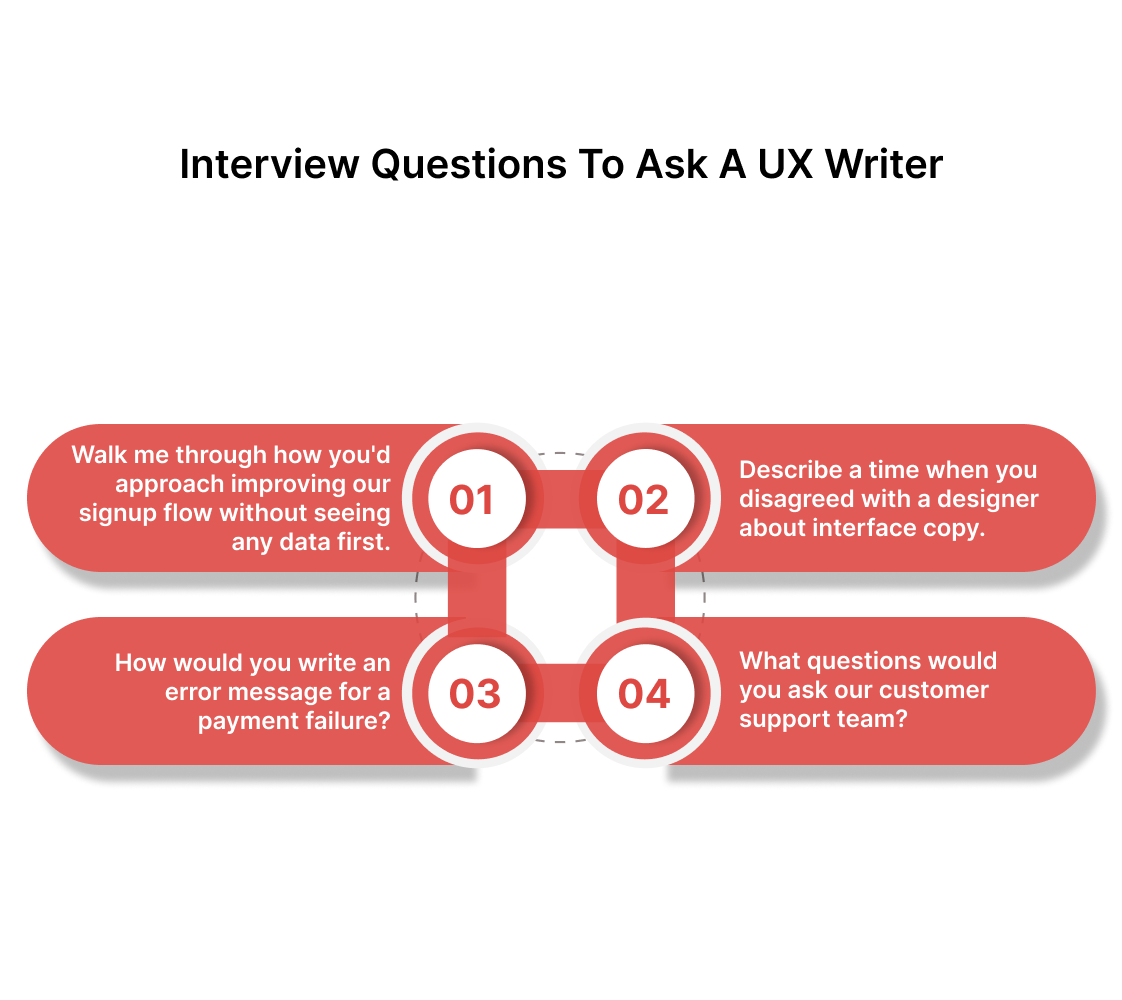Why does finding the right UX writer feel like searching through hundreds of generic portfolios that all look the same? The problem runs deeper than just finding someone who can write clear microcopy.
B2B SaaS products demand writers who understand conversion psychology, technical constraints, and user behavior patterns across complex workflows. Most agencies pitch surface-level solutions while missing the strategic thinking that separates effective UX writing from basic copywriting.
Good UX writing is clarity with consequences. When done right, it moves people through your product with less friction and more intent. That’s where things start to compound. Knowing what to look for before hiring makes all the difference. Let’s help you hire the right UX writer for the job.
Key Takeaways:
- Technical constraints produce better UX copy than creative freedom. Character limits force precision. When every word must justify its existence, fluff disappears and clarity emerges naturally.
- Context beats creativity in microcopy every time. "Your password needs 8 characters" outperforms "Oops!" because users need solutions, not personality during error states.
- Most conversion problems extend beyond button labels. Hiring standalone UX writers treats symptoms. Messaging strategy and user research typically matter more than polishing existing copy.
- Product thinking separates strategic writers from copywriters. The best UX writers ask why users abandon forms before suggesting fixes. Writing skill alone rarely creates effective UX outcomes.
Hiring a UX Writer: What You Think You Need vs. What You Actually Need

You browse portfolios looking for beautiful writing samples and polished case studies. That's your first mistake. Writing talent alone doesn't guarantee UX value because great UX writing isn't about crafting perfect sentences.
1. Writing Talent Alone Doesn't Guarantee UX Value
Your typical copywriter excels at persuasive messaging and brand voice consistency. They create compelling headlines and engaging product descriptions. But UX writing operates under completely different constraints and success metrics.
UX writers must think like product managers first, writers second. They need to understand user flows, technical limitations, and business logic before touching a single word.
When a user hits an error state, the writer doesn't just craft a friendly message - they analyze why the error happens and design copy that guides users toward resolution.
Traditional writers optimize for engagement and memorability. UX writers optimize for task completion and reduced cognitive load. The skills rarely overlap as much as hiring managers assume.
Consider onboarding flows as an example. A traditional writer might create witty welcome messages and clever progress indicators to keep users engaged. But a product-minded UX writer maps the entire user journey first. They identify decision points, potential confusion triggers, and drop-off risks before writing anything.
This approach reveals that users don't need entertainment during setup. They need confidence instead. Clear progress indication matters more than personality, and specific next steps beat motivational copy every time.
Good UX writing becomes invisible to users. They complete tasks without thinking about the words that guided them. Quality UX copy has a direct influence on your UX ROI. According to research, 80% consumers are willing to pay more for better UX, which is influenced significantly by UX writing.
2. Microcopy Needs Context, Not Just Clever Phrasing
Microcopy sits at the intersection of user psychology and technical reality. Context determines everything about what works and what fails spectacularly in real user scenarios.
Take error messages, for instance. A clever writer might craft something like "Oops, something went wrong!" But context reveals the real story.
Did the user trigger this error through their actions? Is it a temporary server issue? Can they fix it themselves?
Context-aware microcopy provides specific solutions instead. "Your password needs at least 8 characters" works better than "Invalid password." Users can act immediately without guessing what went wrong.
The same principle applies to empty states, loading messages, and confirmation dialogs. Generic clever copy frustrates users who need actionable information, while context-driven copy removes uncertainty and keeps workflows moving smoothly.
3. Technical Constraints Shape Better Copy Than Creative Constraints
Technical limitations force UX writers toward clarity and precision in ways creative freedom never could. Character limits eliminate unnecessary words naturally. Loading states demand immediate comprehension. Error handling requires unambiguous language that works under pressure.
These constraints create better user experiences than unlimited creative freedom would. When you have 40 characters for a button label, every word must earn its place. Fluff disappears naturally, and clarity emerges from necessity.
Creative writers often struggle with these restrictions because they're trained to elaborate and embellish their work. But UX writers embrace constraints as design tools that improve communication effectiveness rather than limit it.
4. Don't Confuse Brand Voice With Product Clarity
Brand voice builds emotional connections through personality and tone. Product clarity removes friction through precise, actionable language.
Many writers try to inject brand personality into every interaction, but users completing complex tasks need information, not entertainment. Save the clever quips for marketing pages. In product flows, clarity always wins over creativity.
5. What Separates Strategic UX Writers From Everyone Else
Skilled UX writers understand that their job isn't writing at all. It's problem-solving through words, which requires a completely different skill set. They collaborate with designers on information architecture. They work with developers on technical feasibility. They analyze user research to identify communication gaps that others miss.
They ask questions that reveal deeper product issues.
- Why do users abandon this form?
- What information do they need that we're not providing?
- How can my copy reduce support tickets?
This investigative approach uncovers root causes that pure writing talent misses entirely. The resulting copy is bound to perform better because it addresses real user needs rather than assumed preferences.
Have an individual writer or agency in mind already, but not sure if they are the right fit?
How To Evaluate A UX Writer The Right Way
Traditional hiring methods focus on writing quality and portfolio polish. But those metrics miss the critical thinking skills that make UX writing effective. You need evaluation criteria that reveal how candidates think about users, products, and business outcomes rather than just their ability to write clean copy.
Interview Questions To Ask A UX Writer

Skip the usual "Tell me about yourself" routine. These questions reveal whether candidates think strategically or just write pretty sentences.
- "Walk me through how you'd approach improving our signup flow without seeing any data first." Strong candidates ask about user research, drop-off points, and technical constraints before suggesting solutions. Weak ones jump straight to copy recommendations.
- "Describe a time when you disagreed with a designer about interface copy." This reveals collaboration skills and whether they understand how copy impacts visual hierarchy and user flow decisions.
- "How would you write an error message for a payment failure?" Good answers consider different failure types, user emotions, and next steps. Generic responses show surface-level thinking.
- "What questions would you ask our customer support team?" Strategic candidates want to understand common user problems and friction points. They recognize that support tickets reveal real usability issues.
In addition to asking the above questions, do the following as well for a proper skill assessment:
Assess Their Understanding of Your Specific User Base
Generic UX writing principles don't translate directly across different products and audiences. Ask candidates how they would approach learning about your users and their specific needs.
Any UX writer worth their salt would want to understand user research, support tickets, and behavioral data before writing anything. They will recognize that effective copy requires deep user empathy in addition to impeccable wordsmithing skills.
Evaluate Their Collaboration Skills With Design and Development Teams
UX writing happens within cross-functional teams, not in isolation, as you might already know. Ask about specific examples where they worked with designers on information architecture or collaborated with developers on technical feasibility.
Strong candidates will understand how copy decisions impact visual design and development timelines. They speak the language of product teams, not just marketing departments.
Now you're probably wondering about costs and whether bringing on a dedicated UX writer actually makes sense for your situation. Here's where things get interesting - most SaaS founders discover that their conversion problems run much deeper than just fixing button copy.
How Much Does It Cost To Hire A UX Writer In 2025
Standalone UX writer rates range from $75-200 per hour for freelancers, while agencies charge $150-300 per hour. But focusing purely on hourly rates misses the bigger picture of what your SaaS actually needs to drive growth.
You should decide if hiring a standalone UX writer makes sense when:
- You have a dedicated design team that handles strategy and research
- Your conversion issues are specifically tied to microcopy and interface text
- You already have strong messaging and positioning in place
- Your product team can provide detailed user research and behavioral data
However, most SaaS companies need more than just better button labels and error messages. They need comprehensive conversion optimization that addresses messaging strategy, competitive positioning, and user psychology across the entire customer journey.
Instead of isolated UX writing, consider a full SaaS copywriting package that takes a conversion-driven approach. This includes market research, competitor analysis, product positioning, and internal stakeholder interviews to identify the core messages your customers actually care about.
The process involves creating strategic outlines, writing conversion-focused copy, and implementing UX writing that supports broader business goals.
UX Writing Pricing Estimate and ETA
These comprehensive projects typically range from $3,000 to $20,000 with a 2-8 week timeline. At Beetle Beetle, our process includes thorough market research covering your market landscape, competitors, and product differentiation.
We conduct internal interviews to identify the core messages that your customers care about, then create detailed outlines and write conversion-focused copy, including UX elements that work within your broader messaging strategy.
Amp up Your Conversions With Research-driven Copywriting by Beetle Beetle
A LOT of SaaS websites we come across daily are built on assumptions about what customers want rather than data about what actually converts them. We've spent close to 6 years helping over 100 B2B SaaS brands fix this exact problem through research-first copywriting and strategic design revamps.
Instead of guesstimating why your signups are stalling, we dig into customer interviews and behavioral data to find the real friction points. Then we rebuild your messaging from the ground up, starting with positioning workshops that align your entire team on what actually matters to prospects.
Ready to see what happens when your copy is built on research instead of hunches? Then hire Beetle Beetle for copywriting today.
FAQs
1. What's the difference between UX writing and copywriting for SaaS?
UX writing focuses on task completion and reducing friction within the product interface. Copywriting drives conversions through persuasive messaging on marketing pages. UX writers optimize for usability; copywriters optimize for engagement.
2. How much should I budget for freelance UX writing services?
Freelance UX writers typically charge $75-200 per hour, depending on experience level. Small projects might cost $1,500-5,000, while comprehensive UX audits and rewrites can range from $8,000-15,000 for complex SaaS products.
3. Can I hire a junior UX writer for my SaaS startup?
Junior UX writers often lack the product thinking skills that make UX writing effective. They may write clear copy but miss strategic opportunities to improve user flows. Consider hiring experienced writers or investing in comprehensive training programs.
4. What questions should I ask when interviewing UX writers?
Ask candidates to walk through their research process and explain how they identify user pain points. Request examples of how they've collaborated with design and development teams. Focus on strategic thinking rather than just writing samples.
5. Do I need a full-time UX writer, or can I outsource this work?
Most SaaS companies benefit more from project-based expertise that includes strategy and research. Full-time hires make sense when you have dedicated product teams and ongoing UX optimization needs. Otherwise, comprehensive copywriting packages often deliver better ROI.


.jpg)





























